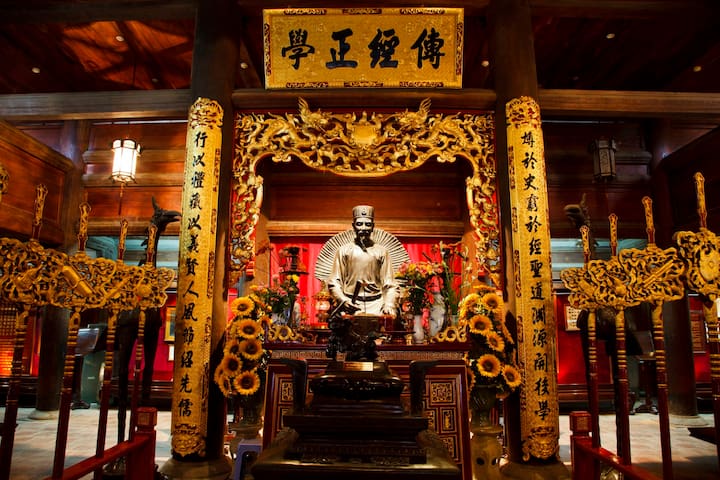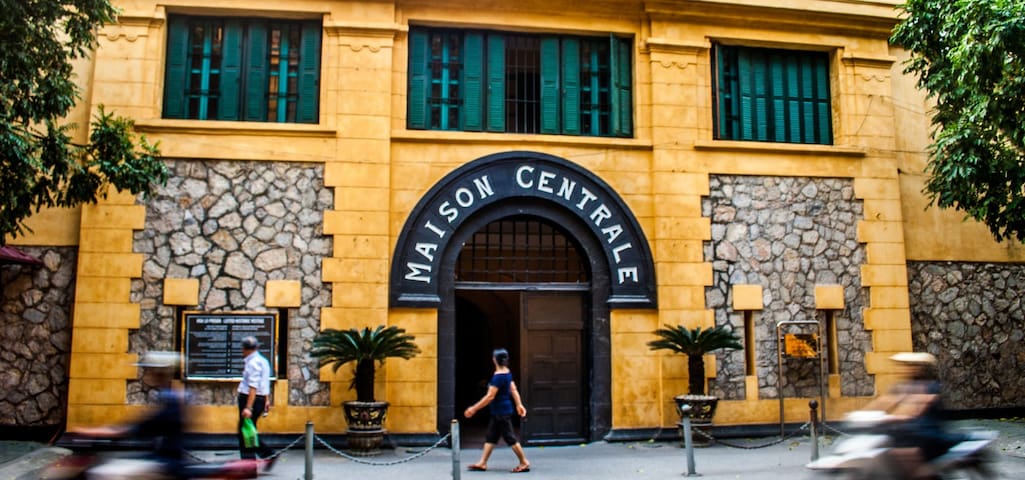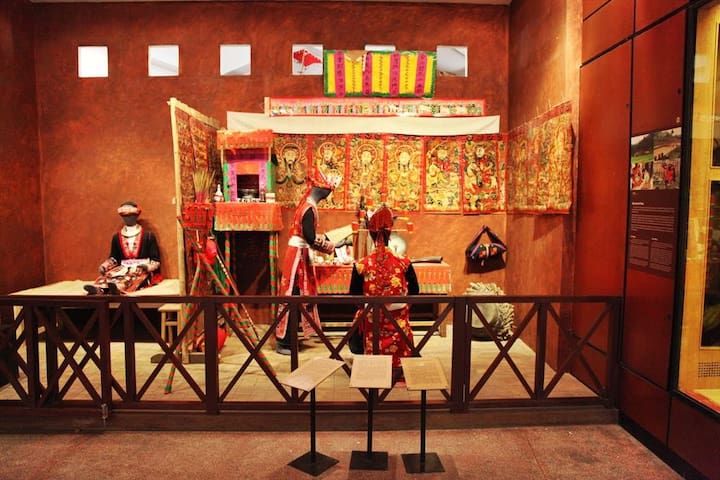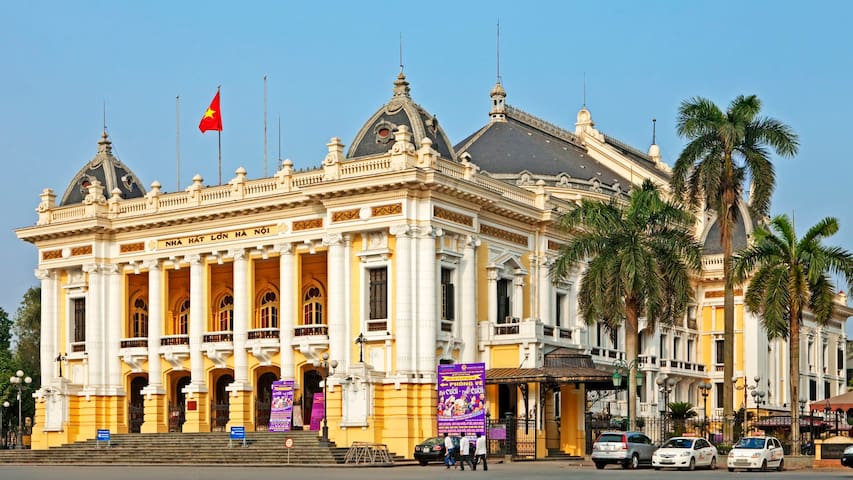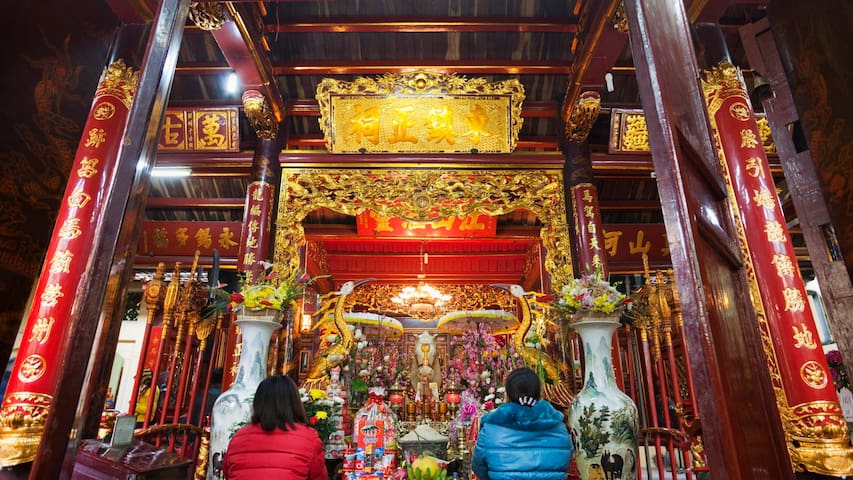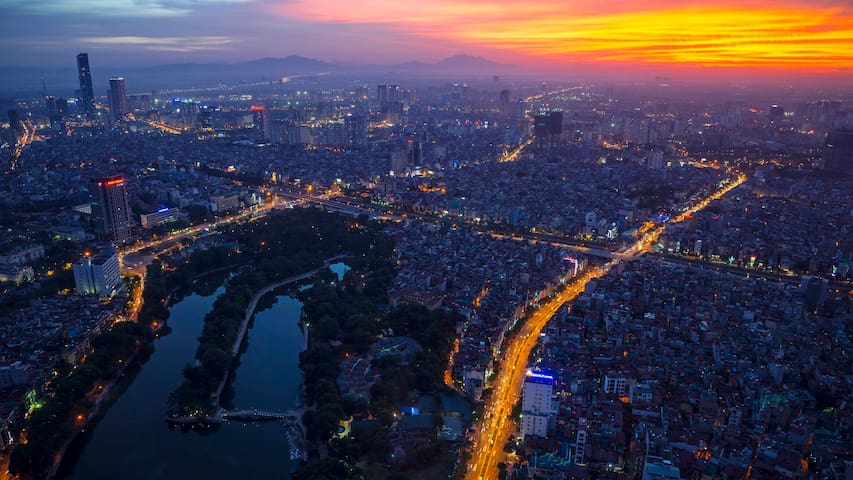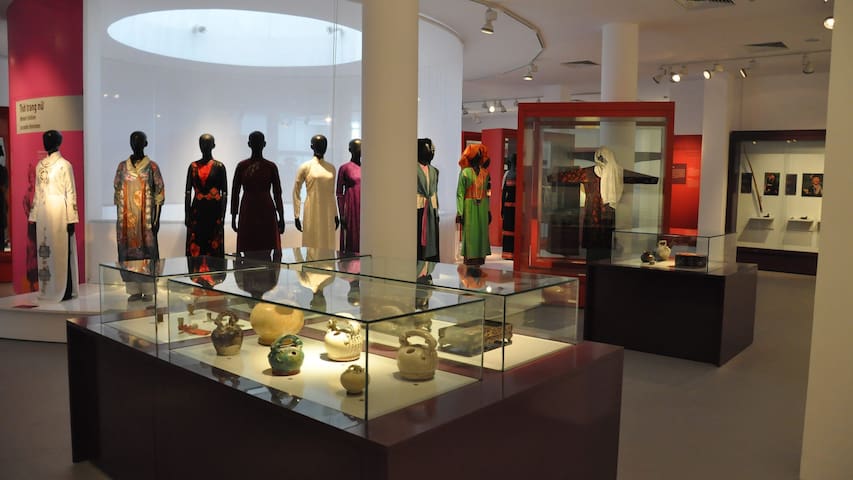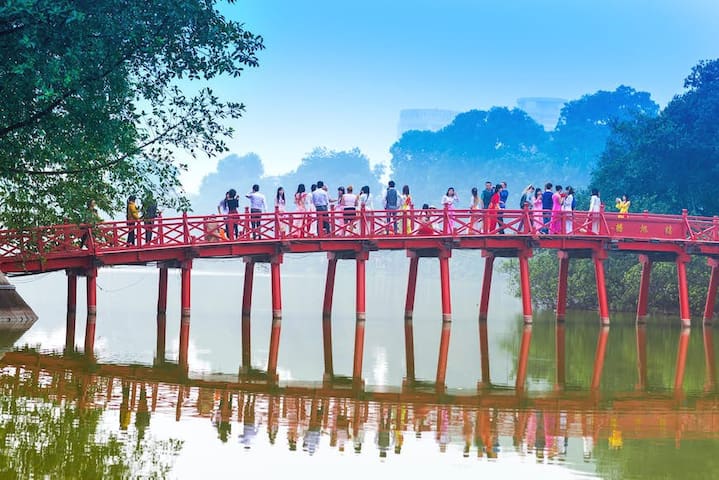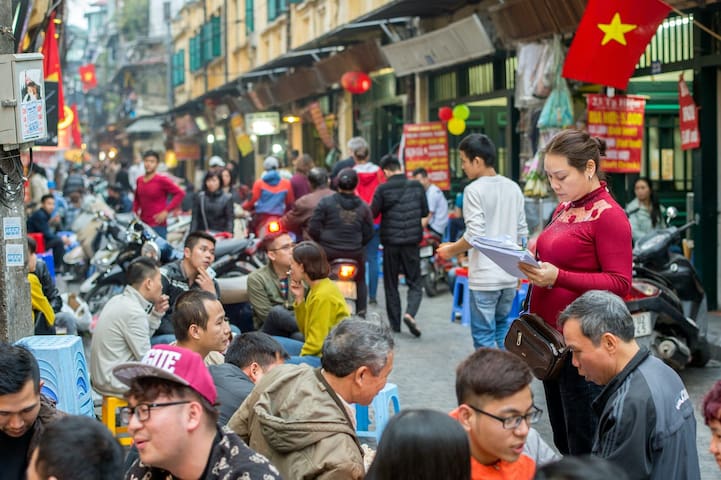Sightseeing
Legend claims that, in the mid-15th century, heaven sent Emperor Le Loi a magical sword, which he used to drive the Chinese from Vietnam. After the war a giant golden turtle grabbed the sword and disappeared into the depths of this lake to restore the sword to its divine owners, inspiring the name Ho Hoan Kiem (Lake of the Restored Sword).
The area is best from Friday to Sunday: nearby traffic is banned between 7pm and midnight and a public-square, funfair vibe takes over.
Every morning at around 6am local residents practise t’ai chi on the shore. Sunset is a lovely time to explore the lake too, and can make for some sublime photographs as the sun sets.
The ramshackle Thap Rua, on an islet near the southern end, is often used as an emblem of Hanoi. A number of elegant pagoda-like stone gateways can be found around the lake, inscribed with chu nho Chinese characters, including Hoa Phong Pagoda (Thap Hoa Phong) near the southeast of the lake shore.
You may often bump into small groups of Hanoi university and high-school students out interviewing foreigners to practise their English. They are invariably polite, often very interesting to talk to and provide an opportunity to interact with local youngsters, while they get the chance to improve their language skills (which the Vietnamese are highly ambitious about)!
513 lokalaca preporučuje
Хоан Кијм језеро
Legend claims that, in the mid-15th century, heaven sent Emperor Le Loi a magical sword, which he used to drive the Chinese from Vietnam. After the war a giant golden turtle grabbed the sword and disappeared into the depths of this lake to restore the sword to its divine owners, inspiring the name Ho Hoan Kiem (Lake of the Restored Sword).
The area is best from Friday to Sunday: nearby traffic is banned between 7pm and midnight and a public-square, funfair vibe takes over.
Every morning at around 6am local residents practise t’ai chi on the shore. Sunset is a lovely time to explore the lake too, and can make for some sublime photographs as the sun sets.
The ramshackle Thap Rua, on an islet near the southern end, is often used as an emblem of Hanoi. A number of elegant pagoda-like stone gateways can be found around the lake, inscribed with chu nho Chinese characters, including Hoa Phong Pagoda (Thap Hoa Phong) near the southeast of the lake shore.
You may often bump into small groups of Hanoi university and high-school students out interviewing foreigners to practise their English. They are invariably polite, often very interesting to talk to and provide an opportunity to interact with local youngsters, while they get the chance to improve their language skills (which the Vietnamese are highly ambitious about)!
Set amidst landscaped grounds near the centre of Hanoi, the Temple of Literature honours Vietnam's finest scholars, and also offers visitors a chance to see a rare example of well-preserved traditional Vietnamese architecture.
Founded in 1070 by Emperor Le Thanh Tong, the attractive complex is dedicated to the Qufu-born philosopher Confucius (Khong Tu) and was the site of Vietnam’s first university, Quoc Tu Giam (1076). The altars are popular with students praying for good grades, while the halls, ponds and gardens of the five courtyards make picturesque backdrops for student graduation photos. The temple is depicted on the 100,000d note.
Originally university admission was exclusively for those born of noble families, but after 1442 it became more egalitarian. Gifted students from all over the nation headed to Hanoi to study the principles of Confucianism, literature and poetry. In 1484 Emperor Ly Thanh Tong ordered that stelae (large slabs) be erected to record the names, places of birth and achievements of exceptional scholars: 82 of 116 stelae remain standing, mostly atop turtle statues. Paths lead from the imposing tiered gateway on P Quoc Tu Giam through formal gardens to the Khue Van pavilion, constructed in 1802.
Entry to the temple is 30,000d for adults and 15,000d for students.
Hotels near the Temple of Literature
Hanoi has accommodation suited to every budget, though an extra US$10 to $20 makes a massive difference in quality: you could easily move from a windowless room to a larger space with a view, so splurge if you can. Good hotel options within walking distance of the Temple of Literature include Tomodachi House and Somerset Grand Hanoi, a 15-minute and 17-minute walk away respectively.
246 lokalaca preporučuje
Temple Of Literature
Temple of LiteratureSet amidst landscaped grounds near the centre of Hanoi, the Temple of Literature honours Vietnam's finest scholars, and also offers visitors a chance to see a rare example of well-preserved traditional Vietnamese architecture.
Founded in 1070 by Emperor Le Thanh Tong, the attractive complex is dedicated to the Qufu-born philosopher Confucius (Khong Tu) and was the site of Vietnam’s first university, Quoc Tu Giam (1076). The altars are popular with students praying for good grades, while the halls, ponds and gardens of the five courtyards make picturesque backdrops for student graduation photos. The temple is depicted on the 100,000d note.
Originally university admission was exclusively for those born of noble families, but after 1442 it became more egalitarian. Gifted students from all over the nation headed to Hanoi to study the principles of Confucianism, literature and poetry. In 1484 Emperor Ly Thanh Tong ordered that stelae (large slabs) be erected to record the names, places of birth and achievements of exceptional scholars: 82 of 116 stelae remain standing, mostly atop turtle statues. Paths lead from the imposing tiered gateway on P Quoc Tu Giam through formal gardens to the Khue Van pavilion, constructed in 1802.
Entry to the temple is 30,000d for adults and 15,000d for students.
Hotels near the Temple of Literature
Hanoi has accommodation suited to every budget, though an extra US$10 to $20 makes a massive difference in quality: you could easily move from a windowless room to a larger space with a view, so splurge if you can. Good hotel options within walking distance of the Temple of Literature include Tomodachi House and Somerset Grand Hanoi, a 15-minute and 17-minute walk away respectively.
This thought-provoking site is all that remains of the former Hoa Lo Prison, ironically nicknamed the ‘Hanoi Hilton’ by US prisoners of war (POWs) during the American War. Most exhibits relate to the prison’s use up to the mid-1950s, focusing on the Vietnamese struggle for independence from France. A gruesome relic is the ominous French guillotine, used to behead Vietnamese revolutionaries. There are also displays focusing on the American pilots who were incarcerated at Hoa Lo during the American War.
These pilots include Pete Peterson (the first US ambassador to a unified Vietnam in 1995) and Senator John McCain (the Republican nominee for the US presidency in 2008). McCain’s flight suit is displayed, along with a photograph of Hanoi locals rescuing him from Truc Bach Lake after being shot down in 1967.
The vast prison complex was built by the French in 1896. Originally intended to house around 450 inmates, records indicate that by the 1930s there were close to 2000 prisoners. Hoa Lo was never a very successful prison, and hundreds escaped its walls over the years – many squeezing out through sewer grates.
Polyglots might notice that the French signs are watered down compared with the English equivalents.
The name 'Hoa Lo' means' 'stove' or 'furnace'. Most of the prison was demolished in the 1990s and high-rises (including the Somerset Grand Hanoi) and other developments were built upon its land, though the section in a corner of the plot containing the museum survives.
212 lokalaca preporučuje
Затвор Хоа Ло
1 Hoả LòThis thought-provoking site is all that remains of the former Hoa Lo Prison, ironically nicknamed the ‘Hanoi Hilton’ by US prisoners of war (POWs) during the American War. Most exhibits relate to the prison’s use up to the mid-1950s, focusing on the Vietnamese struggle for independence from France. A gruesome relic is the ominous French guillotine, used to behead Vietnamese revolutionaries. There are also displays focusing on the American pilots who were incarcerated at Hoa Lo during the American War.
These pilots include Pete Peterson (the first US ambassador to a unified Vietnam in 1995) and Senator John McCain (the Republican nominee for the US presidency in 2008). McCain’s flight suit is displayed, along with a photograph of Hanoi locals rescuing him from Truc Bach Lake after being shot down in 1967.
The vast prison complex was built by the French in 1896. Originally intended to house around 450 inmates, records indicate that by the 1930s there were close to 2000 prisoners. Hoa Lo was never a very successful prison, and hundreds escaped its walls over the years – many squeezing out through sewer grates.
Polyglots might notice that the French signs are watered down compared with the English equivalents.
The name 'Hoa Lo' means' 'stove' or 'furnace'. Most of the prison was demolished in the 1990s and high-rises (including the Somerset Grand Hanoi) and other developments were built upon its land, though the section in a corner of the plot containing the museum survives.
This fabulous collection relating to Vietnam's ethnic minorities features well-presented tribal art, artefacts and everyday objects gathered from across the nation, and examples of traditional village houses. Displays are well labelled in Vietnamese, French and English. If you're into anthropology, it's well worth the Grab motorbike-taxi fare (approximately 40,000d each way) to the Cau Giay district, about 7km from the city centre, where the museum is located.
Otherwise local bus 14 (4000d) departs from P Dinh Tien Hoang on the east side of Hoan Kiem Lake and passes within a couple of blocks (around 600m) of the museum; get off at the Nghia Tan bus stop and head to Ð Nguyen Van Huyen.
147 lokalaca preporučuje
Музеј етнологије Вијетнама
Đường Nguyễn Văn HuyênThis fabulous collection relating to Vietnam's ethnic minorities features well-presented tribal art, artefacts and everyday objects gathered from across the nation, and examples of traditional village houses. Displays are well labelled in Vietnamese, French and English. If you're into anthropology, it's well worth the Grab motorbike-taxi fare (approximately 40,000d each way) to the Cau Giay district, about 7km from the city centre, where the museum is located.
Otherwise local bus 14 (4000d) departs from P Dinh Tien Hoang on the east side of Hoan Kiem Lake and passes within a couple of blocks (around 600m) of the museum; get off at the Nghia Tan bus stop and head to Ð Nguyen Van Huyen.
This humble, traditional stilt house where Ho lived intermittently from 1958 to 1969 is set in a well-tended garden adjacent to a carp-filled pond and has been preserved just as Ho left it. The clear views through the open doorways and windows permit insights more fascinating than many museum displays. The stilt house is now used for official receptions and isn’t open to the public, but visitors may wander the grounds if sticking to the paths.
From here, you look out on to the opulent beaux-arts Presidential Palace. There is a combined entrance gate to the stilt house and palace grounds on P Ong Ich Kiem inside the Ho Chi Minh Mausoleum Complex. When the main entrance is closed, enter from Ð Hung Vuong.
Кућа на стубовима Хо Чи Минха
1 Hoàng Hoa ThámThis humble, traditional stilt house where Ho lived intermittently from 1958 to 1969 is set in a well-tended garden adjacent to a carp-filled pond and has been preserved just as Ho left it. The clear views through the open doorways and windows permit insights more fascinating than many museum displays. The stilt house is now used for official receptions and isn’t open to the public, but visitors may wander the grounds if sticking to the paths.
From here, you look out on to the opulent beaux-arts Presidential Palace. There is a combined entrance gate to the stilt house and palace grounds on P Ong Ich Kiem inside the Ho Chi Minh Mausoleum Complex. When the main entrance is closed, enter from Ð Hung Vuong.
Built between 1925 and 1932, this architecturally impressive museum was formerly home to the École Française d’Extrême-Orient. Its architect, Ernest Hebrard, was among the first in Vietnam to incorporate a blend of Chinese and French design elements. Exhibit highlights include bronzes from the Dong Son culture (3rd century BCE to 3rd century CE), Hindu statuary from the Khmer and Champa kingdoms, jewellery from imperial Vietnam, and displays relating to the French occupation and the Communist Party. The audio guide is free.
The former Museum of the Vietnamese Revolution across the road at 216 Ð Tran Quang Khai is now part of the National Museum of Vietnamese History. The 40,000 exhibits enthusiastically present the histories of conflict and revolution within Vietnam, from the liberation movements against the French occupation to the establishment of the Communist Party and the Socialist Republic of Vietnam.
50 lokalaca preporučuje
Национални музеј историје Вијетнама
216 Đường Trần Quang KhảiBuilt between 1925 and 1932, this architecturally impressive museum was formerly home to the École Française d’Extrême-Orient. Its architect, Ernest Hebrard, was among the first in Vietnam to incorporate a blend of Chinese and French design elements. Exhibit highlights include bronzes from the Dong Son culture (3rd century BCE to 3rd century CE), Hindu statuary from the Khmer and Champa kingdoms, jewellery from imperial Vietnam, and displays relating to the French occupation and the Communist Party. The audio guide is free.
The former Museum of the Vietnamese Revolution across the road at 216 Ð Tran Quang Khai is now part of the National Museum of Vietnamese History. The 40,000 exhibits enthusiastically present the histories of conflict and revolution within Vietnam, from the liberation movements against the French occupation to the establishment of the Communist Party and the Socialist Republic of Vietnam.
A symbol of the tenacity and resilience of the Hanoian people, the Long Bien Bridge (built between 1899 and 1902) was bombed on several occasions during the American War, and each time quickly repaired by the Vietnamese. Designed by Gustave Eiffel (of Eiffel Tower fame), the bridge, used by trains, mopeds and pedestrians, is undergoing reconstruction to restore its original appearance. It's colourfully illuminated at night.
7 lokalaca preporučuje
Long Bien Bridge
Cầu Long BiênA symbol of the tenacity and resilience of the Hanoian people, the Long Bien Bridge (built between 1899 and 1902) was bombed on several occasions during the American War, and each time quickly repaired by the Vietnamese. Designed by Gustave Eiffel (of Eiffel Tower fame), the bridge, used by trains, mopeds and pedestrians, is undergoing reconstruction to restore its original appearance. It's colourfully illuminated at night.
This glorious neoclassical centrepiece of Hanoi's French Quarter is unmissable with its Gothic pillars and domes. The French-colonial 900-seat venue was built in 1911, and on 16 August 1945 the Viet Minh–run Citizens’ Committee announced that it had taken over the city from a balcony in this building. For some drama today, book ahead for a performance here, or take a 50-minute tour (at 2.30pm, 3.30pm or 4.30pm). Most weekends you’ll see Hanoi wedding couples getting photographed on the elegant front steps.
235 lokalaca preporučuje
Ханојска опера
1 Tràng TiềnThis glorious neoclassical centrepiece of Hanoi's French Quarter is unmissable with its Gothic pillars and domes. The French-colonial 900-seat venue was built in 1911, and on 16 August 1945 the Viet Minh–run Citizens’ Committee announced that it had taken over the city from a balcony in this building. For some drama today, book ahead for a performance here, or take a 50-minute tour (at 2.30pm, 3.30pm or 4.30pm). Most weekends you’ll see Hanoi wedding couples getting photographed on the elegant front steps.
The city’s largest lake, West Lake is 15km in circumference and ringed by upmarket suburbs, including the predominantly expat Tay Ho district. On the south side, along Ð Thuy Khue, are seafood restaurants, and to the east, the Xuan Dieu strip is lined with restaurants, cafes, boutiques and luxury hotels. The atmosphere makes a calm change from the chaos of the Old Quarter. A pathway circles the lake, making for a great bicycle ride.
249 lokalaca preporučuje
West Lake
D8, 14 Thụy KhuêThe city’s largest lake, West Lake is 15km in circumference and ringed by upmarket suburbs, including the predominantly expat Tay Ho district. On the south side, along Ð Thuy Khue, are seafood restaurants, and to the east, the Xuan Dieu strip is lined with restaurants, cafes, boutiques and luxury hotels. The atmosphere makes a calm change from the chaos of the Old Quarter. A pathway circles the lake, making for a great bicycle ride.
In the heart of the Old Quarter, the small Bach Ma Temple (literally 'White Horse Temple') is said to be the oldest temple in the city, though much of the current structure dates from the 18th century and a shrine to Confucius was added in 1839. It was originally built by Emperor Ly Thai To in the 11th century to honour a white horse that guided him to this site, where he chose to construct his city walls.
Pass through the wonderful old wooden doors of the pagoda to see a statue of the legendary white horse, as well as a beautiful red-lacquered funeral palanquin. At the time of research the temple was shut for restoration.
17 lokalaca preporučuje
Храм Бах Ма
76 Hàng BuồmIn the heart of the Old Quarter, the small Bach Ma Temple (literally 'White Horse Temple') is said to be the oldest temple in the city, though much of the current structure dates from the 18th century and a shrine to Confucius was added in 1839. It was originally built by Emperor Ly Thai To in the 11th century to honour a white horse that guided him to this site, where he chose to construct his city walls.
Pass through the wonderful old wooden doors of the pagoda to see a statue of the legendary white horse, as well as a beautiful red-lacquered funeral palanquin. At the time of research the temple was shut for restoration.
The city's best views can be found on the 65th-floor 360-degree Observation Deck of the landmark Lotte Center in the western corner of Hanoi's Ba Dinh district. From this uninterrupted vantage point, high above Hanoi's hustle and bustle, you can compare the size of the Old Quarter relative to the sheer scale of Hanoi's voracious growth. Glass-floor sky walks allow you to walk out over the precipitous drop. There's also a rooftop bar on the same floor as an alternative.
The tower also houses a hotel, all manner of restaurants and a department store on its lower floors. The Lotte Center is around 20 minutes by taxi from the Old Quarter.
Лоте Опсервациона Дека
54 Phố Liễu GiaiThe city's best views can be found on the 65th-floor 360-degree Observation Deck of the landmark Lotte Center in the western corner of Hanoi's Ba Dinh district. From this uninterrupted vantage point, high above Hanoi's hustle and bustle, you can compare the size of the Old Quarter relative to the sheer scale of Hanoi's voracious growth. Glass-floor sky walks allow you to walk out over the precipitous drop. There's also a rooftop bar on the same floor as an alternative.
The tower also houses a hotel, all manner of restaurants and a department store on its lower floors. The Lotte Center is around 20 minutes by taxi from the Old Quarter.
This excellent and highly informative museum showcases the roles of women in Vietnamese society and culture. Labelled in English and French, exhibits cover everything from marriage customs to childbirth, but it’s the memories of the wartime contribution by individual heroic women that are most poignant. If the glut of information sometimes feels repetitive, for visual stimulation there is a stunning collection of propaganda posters, as well as costumes, tribal basketware and fabric motifs from Vietnam’s ethnic minority groups. Check the website for special exhibitions.
The audio guide is 30,000d.
127 lokalaca preporučuje
Музеј вијетнамских жена
36 Lý Thường KiệtThis excellent and highly informative museum showcases the roles of women in Vietnamese society and culture. Labelled in English and French, exhibits cover everything from marriage customs to childbirth, but it’s the memories of the wartime contribution by individual heroic women that are most poignant. If the glut of information sometimes feels repetitive, for visual stimulation there is a stunning collection of propaganda posters, as well as costumes, tribal basketware and fabric motifs from Vietnam’s ethnic minority groups. Check the website for special exhibitions.
The audio guide is 30,000d.
Meaning 'Temple of the Jade Mountain', Hanoi's most visited temple sits on a small island in the northern part of Hoan Kiem Lake, connected to the lakeshore by an elegant scarlet bridge (called Cau The Huc), constructed in classical Vietnamese style. The temple is dedicated to General Tran Hung Dao (who defeated the Mongols in the 13th century), La To (patron saint of physicians) and the scholar Van Xuong.
Purchase your ticket from the booth on your right as you enter the grounds and before you cross the bridge.
107 lokalaca preporučuje
Храм Нгок Сон
Phố Đinh Tiên HoàngMeaning 'Temple of the Jade Mountain', Hanoi's most visited temple sits on a small island in the northern part of Hoan Kiem Lake, connected to the lakeshore by an elegant scarlet bridge (called Cau The Huc), constructed in classical Vietnamese style. The temple is dedicated to General Tran Hung Dao (who defeated the Mongols in the 13th century), La To (patron saint of physicians) and the scholar Van Xuong.
Purchase your ticket from the booth on your right as you enter the grounds and before you cross the bridge.
Impressive water puppet performances have turned Thang Long Water Puppet Theater into the ideal attraction to tourists when participating in Hanoi travel.
Vietnamese water puppetry originated in the 11th century from the flooded paddy fields of the Red River Delta, and visitors shouldn't miss this unique local form of art when in Hanoi. Expert puppeteers maneuver wooden figurines tied to long poles over pools that serve as liquid stages, using water splashes to choreographic three-dimensional effect. Hanoi’s most famous Water Puppet theater is Thang Long in the city center, hosting up to five multi-lingual shows per day.
207 lokalaca preporučuje
Тханг Лонг водени позориште
57B Đinh Tiên HoàngImpressive water puppet performances have turned Thang Long Water Puppet Theater into the ideal attraction to tourists when participating in Hanoi travel.
Vietnamese water puppetry originated in the 11th century from the flooded paddy fields of the Red River Delta, and visitors shouldn't miss this unique local form of art when in Hanoi. Expert puppeteers maneuver wooden figurines tied to long poles over pools that serve as liquid stages, using water splashes to choreographic three-dimensional effect. Hanoi’s most famous Water Puppet theater is Thang Long in the city center, hosting up to five multi-lingual shows per day.
Dive into the Old Quarter
Hanoi's Old Quarter is the city's busiest attraction, and it’s an unmissable attack to the senses. Buzzing motorbikes maneuver around people in large conical straw hats pushing carts laden with goods along streets lined with French colonial buildings. Come right after sunrise when the light casts ethereal hues over the century-old facades, and find only the most industrious locals busy setting up shop for the day. Signing up for a walking food tour with a local is another good way to explore the quarter’s 36 streets and the best dishes that represent them.
110 lokalaca preporučuje
Стари град
Phố Lương Ngọc QuyếnDive into the Old Quarter
Hanoi's Old Quarter is the city's busiest attraction, and it’s an unmissable attack to the senses. Buzzing motorbikes maneuver around people in large conical straw hats pushing carts laden with goods along streets lined with French colonial buildings. Come right after sunrise when the light casts ethereal hues over the century-old facades, and find only the most industrious locals busy setting up shop for the day. Signing up for a walking food tour with a local is another good way to explore the quarter’s 36 streets and the best dishes that represent them.

